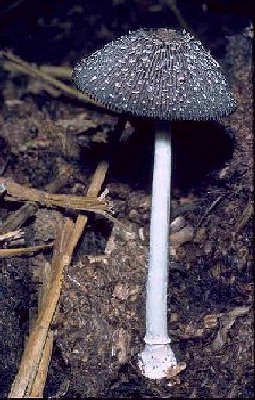Macroscopic features |
Pileus 40-60 x 20-30 mm when still closed, ellipsoid or ovoid, expanding to conical and than up to 60 mm wide, first white, first fibrillose flocculose, then more coarsely scaly with pale or deep cream centre. Lamellae, L = > 50, l = 3-7, first white, than grey to black. Stipe 80-150 x 4-8 mm with movable ring on lower part; base up to 12 mm and subbulbous. |
Microscopic features |
Spores c. 17-26 x 10-15 µm, Q = 1.55-1.85, av. Q = 1.65, av. L = 23-24.2 µm, av. B = 14-14.6 µm, ellipsoid or ovoid with rounded base and apex, very dark red-brown, almost black; germ pore slightly eccentric, 2.5-2.8 µm wide. Basidia 32-54 x 13-16 µm, 4-spored, surrounded by 5-8 pseudoparaphyses. Pleurocystidia absent. Cheilocystidia 35-60 x 18-25 µm, ellipsoid, ovoid or broadly utriform. Elements of veil 30-200 x 8-25 µm, in chains. Only pseudo clamps present. |
Habitat & distribution |
On dung or mixed dung, usually of horse. Solitary. Wide-spread in Europe, Asia and America but very rare. |
Remarks |
Coprinus sterquilinus is easy to recognize by the very large, ellipsoid spores and the habitat on dung. |

[Copyright © by Hans Bender jbe8995374@aol.com]